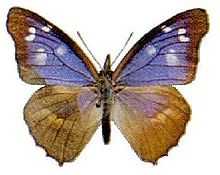Libythea geoffroy
| Purple Beak | |
|---|---|
 | |
| Scientific classification | |
| Kingdom: | Animalia |
| Phylum: | Arthropoda |
| Class: | Insecta |
| Order: | Lepidoptera |
| Family: | Nymphalidae |
| Genus: | Libythea |
| Species: | L. geoffroy |
| Binomial name | |
| Libythea geoffroy Godart, [1824] | |
| Synonyms | |
| |
The Purple Beak (Libythea geoffroy) is a butterfly found in parts of India and Myanmar that belongs to the Libytheinae group of the Brush-footed butterflies family.
Description
- See glossary for terms used.
Race alompra, Moore. Male upperside is pale brown. Fore wing: the cell, basal two-thirds of interspaces 1a, 1, 2 and 3, and the extreme base of interspace 4 suffused with a beautiful pale violescent blue; a curved series of three subquadrate preapical white spots. Hind wing : cell suffused with violescent blue extending faintly into interspaces 4, 5 and 6 ; a faintly-marked dull orange band below the lower apex of cell. Underside pale brown. If ore wing: apex grey, irrorated with minute dark spots; cell with a broad dull orange streak from base, followed by a violescent transverse spot in apex of cell; a large discal dull violescent spot in interspace 2 spreading slightly into interspace 3,. the curved series of three preapical spots as on the upperside but faintly dull violescent. Hind wing greyish brown, irrorated with dark spots and transverse dark striae and shaded with darker brown; the medial dull orange band replaced by a similar pale well-marked baud. Antennae, head and abdomen pale brown; thorax darker brown with a little greenish pubescence posteriorly; beneath, the palpi, thorax and abdomen pale greyish brown.
Female upperside: forewing with the violet area duller and confined to the immediate base of the wing; a quadrate white spot at the end of the discoidal cell; a tripartite subcostal spot; another elongated spot from the third median to the upper discoidal nervule, placed outwardly below it; a large quadrate discal spot, completely tilling the interspace between the first and third median nervules. Hind wing with no violet gloss at the base, otherwise as in the male. Underside: fore wing with the cell orange but outwardly terminated by a large white spot; the other spots as on the upperside- Hind wing as in the male, but all the markings mores obscure. (After Lionel de Nicéville)[1]
Notes
- ↑ Bingham, C. T. 1905. Fauna of British India. Butterflies. Volume 1.
References
- Evans, W.H. (1932) The Identification of Indian Butterflies. (2nd Ed), Bombay Natural History Society, Mumbai, India
- Gaonkar, Harish (1996) Butterflies of the Western Ghats, India (including Sri Lanka) - A Biodiversity Assessment of a threatened mountain system. Journal of the Bombay Natural History Society.
- Gay,Thomas; Kehimkar,Isaac & Punetha,J.C.(1992) Common Butterflies of India. WWF-India and Oxford University Press, Mumbai, India.
- Haribal, Meena (1994) Butterflies of Sikkim Himalaya and their Natural History.
- Kunte,Krushnamegh (2005) Butterflies of Peninsular India. Universities Press.
- Wynter-Blyth, M.A. (1957) Butterflies of the Indian Region, Bombay Natural History Society, Mumbai, India.